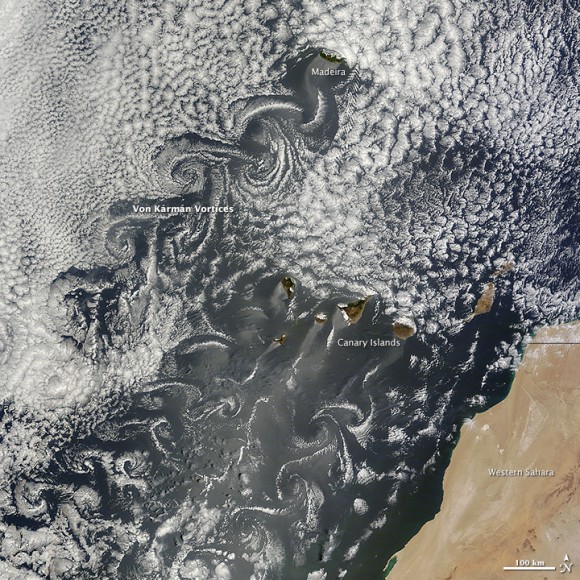1/15
![]()
This image from May 3, 2016, shows von Kármán vortices near Heard Island in the southwest Indian Ocean. (NASA)
||

This phenomenon is not just related to clouds; it can happen anywhere that fluid flow is disturbed by an object, according to NASA's website on von Karman vortices
Posted by
https://www.sogou.com/link?url=hedJjaC291Mz5fVHp63yS_pXlpr8TNLzQp87vX79vKUgVgYMzMpWpd1m8hfyWnJqlh6Fscrv53NuGGn0nqLfow..
June 11, 2015

NASA’s Terra satellite captured this view of several cloud vortices swirling downwind of the Canary Islands and Madeira on May 20, 2015. Image credit: NASA
Theodore von Kármán (1881-1963), a Hungarian-American physicist, was the first to describe the physical processes that create long chains of spiral eddies like the ones shown above. Known as von Kármán vortices, the patterns can form nearly anywhere that fluid flow is disturbed by an object. In this case, the unique flow occurs as winds rush past the tall peaks on the volcanic islands. As winds are diverted around these high areas, the disturbance in the flow propagates downstream in the form of vortices that alternate their direction of rotation.
Satellite sensors have spotted von Kármán vortices around the globe before, including off of Guadalupe Island, near the coast of Chile, in the Greenland Sea, in the Arctic, and even next to a tropical storm. The scene above is particularly notable for the fact that three distinct streams of vortices are visible.
 These turbulence patterns are known as von Karman vortex streets. In these images from NASA’s Multi-angle Imaging SpectroRadiometer, an impressive vortex pattern continues for over 300 km southward of Jan Mayen island. Jan Mayen is an isolated territory of Norway, located about 650 km northeast of Iceland in the north Atlantic Ocean. Jan Mayen’s Beerenberg volcano rises about 2.2 km above the ocean surface, providing a significant impediment to wind flow. June 6, 2001. Image credit: NASA
These turbulence patterns are known as von Karman vortex streets. In these images from NASA’s Multi-angle Imaging SpectroRadiometer, an impressive vortex pattern continues for over 300 km southward of Jan Mayen island. Jan Mayen is an isolated territory of Norway, located about 650 km northeast of Iceland in the north Atlantic Ocean. Jan Mayen’s Beerenberg volcano rises about 2.2 km above the ocean surface, providing a significant impediment to wind flow. June 6, 2001. Image credit: NASA
Cape Verde 佛得角
https://earthobservatory.nasa.gov/images/147743/the-stability-of-von-karmans-vortices

December 20, 2020JPEG
On a clear day, the towering peaks on Fogo, Santa Antão, and São Nicolau stand out amid the flatter islands of Cabo Verde (Cape Verde). These three volcanic islands, the tallest in the archipelago, stand high enough to generate rain shadow effects that support unique dry forests on some of the islands.
The height also helps these islands disturb passing air masses and clouds in a way that Theodore von Kármán—an accomplished mathematician, aerospace engineer, and one of the Jet Propulsion Laboratory’s founders—likely would have appreciated. The trails are called von Kármán vortex streets, a distinctive pattern that can occur when a fluid passes a tall, isolated, stationary object. In 1912, von Kármán was the first to describe the oscillating flow features in mathematical terms while he was working as a graduate assistant for the pioneering German fluid dynamicist Ludwig Prandtl.
Though a French scientist was the first to photograph the feature, von Kármán’s key insight was a mathematical proof demonstrating that staggered vortices were the most lasting flow pattern that such features can produce. “I found that only the anti-symmetric arrangement could be stable, and only for a certain ratio of the distance between the rows and the distance between two consecutive vortices of each row,” von Kármán later wrote about the discovery. In other words, the vortices are always offset and never line up.
The Moderate Resolution Imaging Spectroradiometer (MODIS) on NASA’s Terra captured this image of the swirling trails of clouds on December 20, 2020. The dry forests appear slightly darker than the rest of the islands.
Von Kármán was a student at the University of Göttingen (Germany) when he made his insight about the vortices. He remained in Germany until 1930, with a three-year interruption to serve in the Austro-Hungarian army. Concerned about the rise of the Nazis in Germany, von Kármán accepted an offer to direct the new Daniel Guggenheim Aeronautical Laboratory at the California Institute of Technology in 1930. That lab later became NASA’s Jet Propulsion Laboratory in 1958.
NASA Earth Observatory image by Lauren Dauphin, using MODIS data from NASA EOSDIS/LANCE and GIBS/Worldview. Story by Adam Voiland.
Encyclopedia Brittanica (2020) Theodore von Kármán. Accessed January 4, 2021.
Govardhan, R.M. and O.N. Ramesh (2005, August) A Stroll down Karman Street. Accessed January 4, 2021.
Jet Propulsion Laboratory (2020) Dr. Theodore von Kármán (1881-1963). Accessed January 4, 2021.

1/15 This image from May 3, 2016, shows von Kármán vortices near Heard Island in the southwest Indian Ocean. (NASA)![]()
https://www.nesdis.noaa.gov/sites/default/files/2021_05_13_vonKarmanVortices_NoText.mp4
Archiver|手机版|科学网 ( 京ICP备07017567号-12 )
GMT+8, 2025-1-25 08:26
Powered by ScienceNet.cn
Copyright © 2007- 中国科学报社